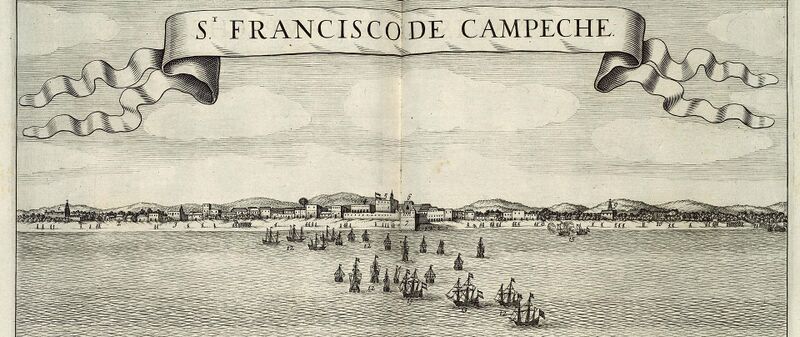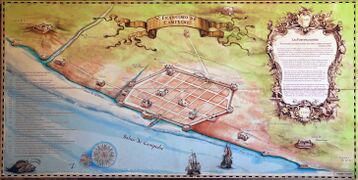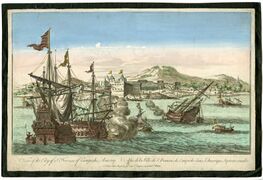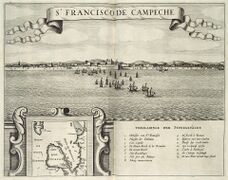Difference between revisions of "Campeche"
(→Timeline) |
|||
| (4 intermediate revisions by the same user not shown) | |||
| Line 15: | Line 15: | ||
=Government= | =Government= | ||
| − | *Captaincy-General of Yucatán: Currently between governors—last was Antonio Cortaire y Terreros, out (for reasons?) in 14 Dec 1724 | + | *Captaincy-General of Yucatán: Currently between governors—last was Antonio Cortaire y Terreros, out (for reasons?) in 14 Dec 1724. Capital is in Mérida. |
| − | *Mayor, Town Council, etc. | + | *Mayor, ''Cabildo'' (Town Council), etc.<br> |
| + | :''A uniqueness of the ''cabildo'' in Campeche, which distinguished it from the rest of the municipal governments in the peninsula, was that the ''alcalde'' of first vote was also named the lieutenant of general captain, so he oversaw everything related to the war and the defense of the town. This situation caused conflicts between the governor and the ''cabildo'' in Campeche, since the governor was often unable to impose his authority.'' | ||
=Locations= | =Locations= | ||
| Line 32: | Line 33: | ||
=Timeline= | =Timeline= | ||
| + | 24 Feb 1725 | ||
| + | *Arrived in afternoon | ||
| + | *Dined with [[Gordon Reade]] in the evening of 25 Feb | ||
| + | *Expedition to the Treasury on 1 Mar | ||
=Gallery= | =Gallery= | ||
Latest revision as of 19:12, 7 July 2023
| Campeche, Yucatán | ||||||||||||
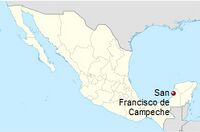
| ||||||||||||
| ||||||||||||

|
See Wikipedia
St. Francisco de Campeche is a very well established Spanish city designed with an ‘old’ look to it, suiting the aristocratic tastes of its many landowners and wealthy merchants. It is an important crossroads between the east and the lands of New Spain.
Government
- Captaincy-General of Yucatán: Currently between governors—last was Antonio Cortaire y Terreros, out (for reasons?) in 14 Dec 1724. Capital is in Mérida.
- Mayor, Cabildo (Town Council), etc.
- A uniqueness of the cabildo in Campeche, which distinguished it from the rest of the municipal governments in the peninsula, was that the alcalde of first vote was also named the lieutenant of general captain, so he oversaw everything related to the war and the defense of the town. This situation caused conflicts between the governor and the cabildo in Campeche, since the governor was often unable to impose his authority.
Locations
Fortifications
Due to the constant attacks of both English and Dutch buccaneers and pirates such as Francis Drake, John Hawkins, Laurens de Graaf, Cornelis Jol, Jacobo Jackson, Jean Lafitte, Francisco de Grammont, Bartolomé Portugués, William Parker, Francisco Nau, Edward Mansvelt, Henry Morgan, Lewis Scot, Roche Braziliano and Michel de Grammont for almost 160 years, in 1686 the government started to fortify the city. The French engineer Louis Bouchard de Becour was commissioned to unify all the defensive works that surrounded the city with a wall. At its completion, the wall surrounding the city of Campeche was 2,560 meters in length, forming an irregular hexagon around the main part of the city, with eight defensive bastions on the corners:
- Santiago:
- San Pedro:
- San Francisco: Protects the Land Gate.
- San Juan: Protects the Land Gate.
- Nuestra Señora de la Soledad: Also protects the Sea Gate. It is the largest one.
- San Carlos: This fort was the first one built. Protects the Sea Gate.
- Santa Rosa
It also contained four gates to allow access to the main quarters. The main entrances are what would become the Puerta de la tierra ("Land Gate"; built in 1732), and the Puerta del mar ("Sea Gate"). The other gates were Guadalupe and San Román, connecting to the outside neighborhoods.
Additionally, one fort protected the city from a nearby hill (around 2 miles down the south coast), the fort of Santa Cruz. The fort gave long-range artillery coverage and served also as a look-out. It was built before the walls of the city.
Timeline
24 Feb 1725
- Arrived in afternoon
- Dined with Gordon Reade in the evening of 25 Feb
- Expedition to the Treasury on 1 Mar
Gallery
Trivia
- The fort of Santa Cruz is briefly mentioned in conjunction with the Morgan/Myng raid in 1663, but I haven't been able to find an actual location. There are two forts standing today, but both began construction long after the campaign period. So I'm just handwaving the location, putting it on the same hill as the later Fuerte de San Miguel, and assuming that was built on top of a demolished Santa Cruz site.
